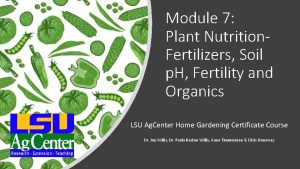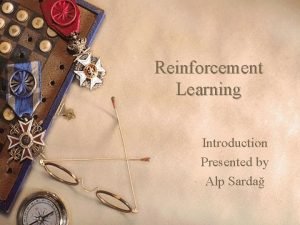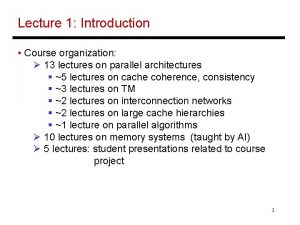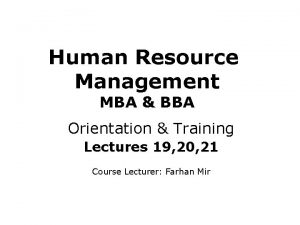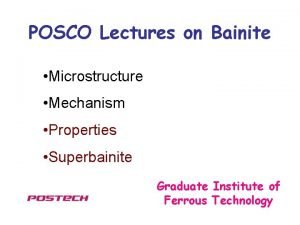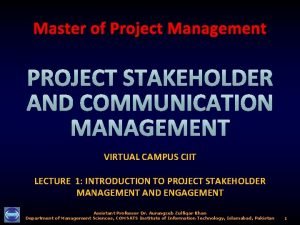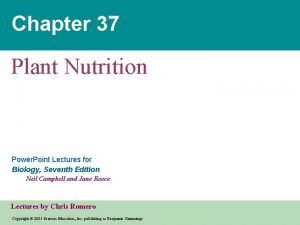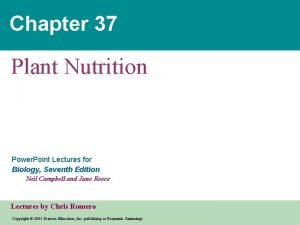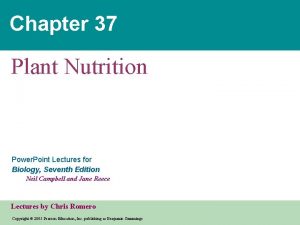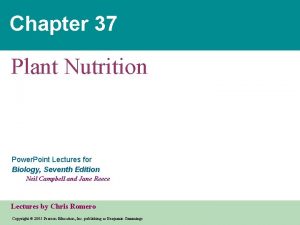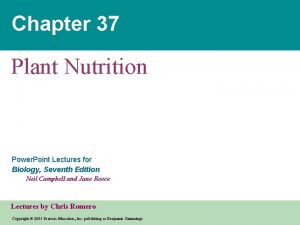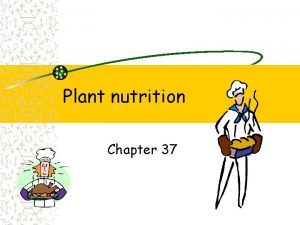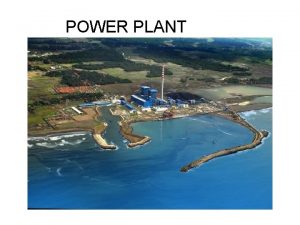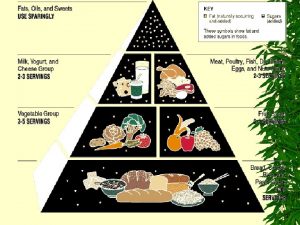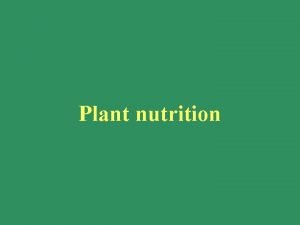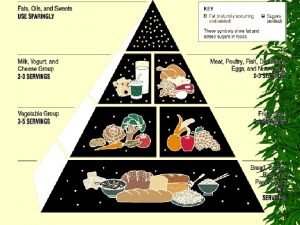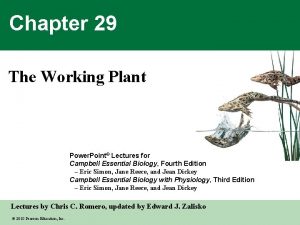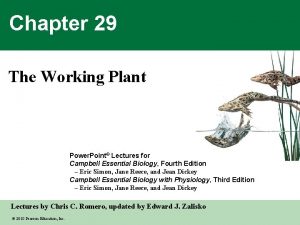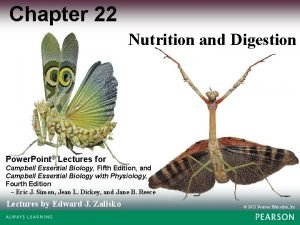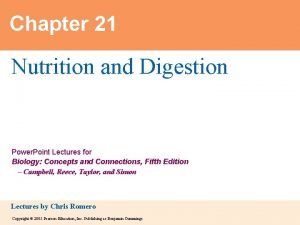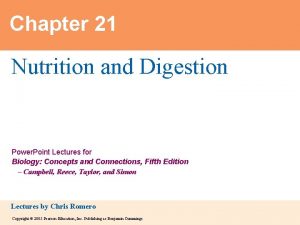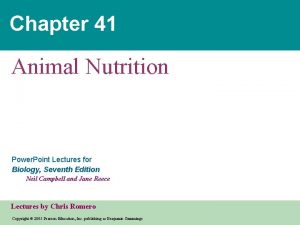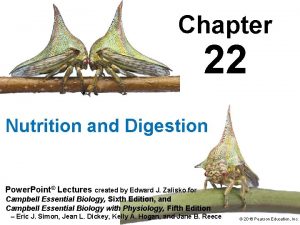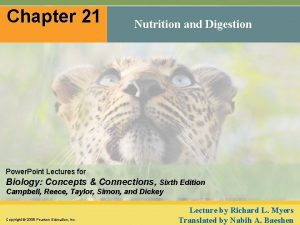Chapter 37 Plant Nutrition Power Point Lectures for















































- Slides: 47

Chapter 37 Plant Nutrition Power. Point Lectures for Biology, Seventh Edition Neil Campbell and Jane Reece Lectures by Chris Romero Copyright © 2005 Pearson Education, Inc. publishing as Benjamin Cummings

Overview: A Nutritional Network • Every organism continually exchanges energy & materials with its environment • For a typical plant, water & minerals come from the soil, while CO 2 comes from the air • The root and shoot systems of a vascular plant ensure extensive networking with both reservoirs of inorganic nutrients Copyright © 2005 Pearson Education, Inc. publishing as Benjamin Cummings

Copyright © 2005 Pearson Education, Inc. publishing as Benjamin Cummings

37. 1: Plants require certain chemical elements to complete their life cycle • Plants derive most of their organic mass from the CO 2 of air, but they also depend on soil nutrients such as water and minerals Copyright © 2005 Pearson Education, Inc. publishing as Benjamin Cummings

LE 37 -2 H 2 O CO 2 O 2 Minerals CO 2 H 2 O

Macronutrients and Micronutrients • > 50 chem elements r inorganic substances in plants, but not all of these are essential to plants • chem element is essential if it is req’d for a plant to complete its life cycle • Researchers use hydroponic culture to determine which chemicals elements are essential • *plants are grown in mineral soln’s w/o soil & roots are bathed in aerated solns to provide O 2 for respiration. A mineral such as K can be omitted to see if it’s essential Copyright © 2005 Pearson Education, Inc. publishing as Benjamin Cummings

LE 37 -3 Control: Solution containing all minerals Experimental: Solution without potassium

Copyright © 2005 Pearson Education, Inc. publishing as Benjamin Cummings

• 9 essential elements r macronutrients b/c plants require them in lg amts • 8 are micronutrients b/c plants only need small amts Copyright © 2005 Pearson Education, Inc. publishing as Benjamin Cummings

Symptoms of Mineral Deficiency • Symptoms of mineral deficiency depend on the nutrient’s function & mobility w/in the plant • Deficiency of a mobile nutrient usually affects older organs > young ones (b/c young growing tissues have more “drawing” power for nutrients in short supply) • Deficiency of a less mobile nutrient usually affects younger organs > older ones (b/c older tissues will have enough of the mineral & so can retain when it’s in shor supply) • most common: N, K, & P Copyright © 2005 Pearson Education, Inc. publishing as Benjamin Cummings

• Chlorosis- yellowing of leaves due to insufficient production of chlorophyll • deficiency of Mg caused yellowing of the leaves b/c it’s a part of chlorophyll • **iron deficiency also causes yellowing even though it is not in chlorophyll but it’s req’d as a cofactor in one of the enzymatic steps of chlorophyll synthesis Copyright © 2005 Pearson Education, Inc. publishing as Benjamin Cummings

LE 37 -4 Healthy Phosphate-deficient Potassium-deficient Nitrogen-deficient

37. 2: Soil quality is a major determinant of plant distribution and growth • Climate, soil texture & composition- major factors determining whether a plant can grow well in a location • Texture- soil’s general structure • Composition- soil’s organic & inorganic chemical components • **usually mineral deficiencies are distinctive enough so that farmers can tell by looking or by checking the mineral content of the soil Copyright © 2005 Pearson Education, Inc. publishing as Benjamin Cummings

Texture and Composition of Soils • Topsoil- mix of rock particles, living organisms, & humus (the remains of partially decayed organic material) • The topsoil and other distinct soil layers, or horizons, are often visible in vertical profile where there is a road cut or deep hole • ** most fertile soils are loams + humus (= amts of sand, silt, & clay) • * they have enough fine particles to provide a lg surface area to retain water & minerals & enough coarse particles to provide air spaces Copyright © 2005 Pearson Education, Inc. publishing as Benjamin Cummings

LE 37 -5 A B C

• After a heavy rainfall, water drains from the larger spaces of soil, but smaller spaces retain water because of its attraction to clay and other particles • The film of loosely bound water is usually available to plants Animation: How Plants Obtain Minerals from Soil Copyright © 2005 Pearson Education, Inc. publishing as Benjamin Cummings

LE 37 -6 Soil particle surrounded by film of water Root hair Soil particle Water available to plant Root hair Air space Soil water Cation exchange in soil

• Acids derived from roots contribute to a plant’s uptake of minerals when H+ displaces mineral cations (+) from clay particles Copyright © 2005 Pearson Education, Inc. publishing as Benjamin Cummings

Soil Conservation and Sustainable Agriculture • In contrast w/ natural ecosystems, agriculture depletes the mineral content of soil, taxes water reserves, & encourages erosion • The goal of soil conservation strategies is to minimize this damage Copyright © 2005 Pearson Education, Inc. publishing as Benjamin Cummings

Fertilizers • Commercial fertilizers- minerals mined or prepped by industrial processes • Organic fertilizers- manure, fishmeal, or compost Copyright © 2005 Pearson Education, Inc. publishing as Benjamin Cummings

• Agricultural researchers are developing ways to maintain crop yields while reducing fertilizer use • Genetically engineered “smart” plants inform the grower when a nutrient deficiency is imminent Copyright © 2005 Pearson Education, Inc. publishing as Benjamin Cummings

LE 37 -7 No phosphorus deficiency Beginning phosphorus deficiency Well-developed phosphorus deficiency

Irrigation • Irrigation is a huge drain on water resources when used for farming in arid regions • It can change the chemical makeup of soil Copyright © 2005 Pearson Education, Inc. publishing as Benjamin Cummings

Erosion • Topsoil from 1000 s of acres of farmland is lost to water & wind erosion each year in the USA • Contour tillage- prevents topsoil loss Copyright © 2005 Pearson Education, Inc. publishing as Benjamin Cummings

Copyright © 2005 Pearson Education, Inc. publishing as Benjamin Cummings

• The goal of soil management is sustainable agriculture, a commitment embracing a variety of farming methods that are conservation-minded Copyright © 2005 Pearson Education, Inc. publishing as Benjamin Cummings

Soil Reclamation • Some areas are unfit for agriculture because of contamination of soil or groundwater with toxic pollutants • Phytoremediation- biological, nondestructive technology that reclaims contaminated areas using plants • Bioremediation- using bacteria or protists to clean polluted sites Copyright © 2005 Pearson Education, Inc. publishing as Benjamin Cummings

37. 3: Nitrogen is often the mineral that has the greatest effect on plant growth • Plants require N as a component of proteins, nucleic acids, chlorophyll, & other impt organic molecules Copyright © 2005 Pearson Education, Inc. publishing as Benjamin Cummings

Soil Bacteria and Nitrogen Availability • N-fixing bacteria convert atmospheric N 2 to nitrogenous minerals that plants can absorb as a N source for organic synthesis Copyright © 2005 Pearson Education, Inc. publishing as Benjamin Cummings

Improving the Protein Yield of Crops • Agriculture research in plant breeding has resulted in new varieties of maize, wheat, and rice that are enriched in protein • Such research addresses the most widespread form of human malnutrition: protein deficiency Copyright © 2005 Pearson Education, Inc. publishing as Benjamin Cummings

37. 4: Plant nutritional adaptations often involve relationships with other organisms • 2 types of relationships plants have w/ other organisms are mutualistic: – Symbiotic N-fixation, involving roots & bacteria – Mycorrhizae, involving roots & fungi Copyright © 2005 Pearson Education, Inc. publishing as Benjamin Cummings

The Role of Bacteria in Symbiotic Nitrogen Fixation • Symbiotic relationships with N-fixing bacteria provide some plant spp with a built-in source of fixed N • For agriculture, the key symbioses b/w plants & Nfixing bacteria occur in the legume family (peas, beans, and other similar plants) Copyright © 2005 Pearson Education, Inc. publishing as Benjamin Cummings

• legume roots- swellings (nodules), plant cells “infected” by N-fixing Rhizobium bacteria Copyright © 2005 Pearson Education, Inc. publishing as Benjamin Cummings

LE 37 -10 5 µm Bacteroids within vesicle Nodules Roots Pea plant root. Bacteroids in a soybean root nodule.

• Inside the root nodule, Rhizobium bacteria assume a form called bacteroids, which are contained within vesicles formed by the root cell Copyright © 2005 Pearson Education, Inc. publishing as Benjamin Cummings

The Molecular Biology of Root Nodule Formation • The development of a N-fixing root nodule depends on chemical dialogue b/w Rhizobium bacteria & root cells of their specific plant hosts Copyright © 2005 Pearson Education, Inc. publishing as Benjamin Cummings

Symbiotic Nitrogen Fixation and Agriculture • Crop rotation takes advantage of the agricultural benefits of symbiotic N-fixation • A non-legume such as maize is planted 1 year, & the next year a legume is planted to restore the concen of N in the soil Copyright © 2005 Pearson Education, Inc. publishing as Benjamin Cummings

Mycorrhizae and Plant Nutrition • Mycorrhizae are mutualistic associations of fungi and roots • The fungus benefits from a steady supply of sugar from the host plant • The host plant benefits because the fungus increases the surface area for water uptake and mineral absorption Copyright © 2005 Pearson Education, Inc. publishing as Benjamin Cummings

The Two Main Types of Mycorrhizae • Ectomycorrhizae-mycelium of the fungus forms a dense sheath over the surface of the root Copyright © 2005 Pearson Education, Inc. publishing as Benjamin Cummings

LE 37 -12 a Epidermis Cortex Mantle (fungal sheath) 100 µm Endodermis Fungal hyphae between cortical cells Mantle (fungal sheath) Ectomycorrhizae. (colorized SEM)

• Endomycorrhizae-microscopic fungal hyphae extend into the root Copyright © 2005 Pearson Education, Inc. publishing as Benjamin Cummings

LE 37 -12 b Epidermis Cortex Cortical cells 10 µm Endodermis Fungal hyphae Vesicle Casparian strip Root hair Arbuscules (LM, stained specimen) Endomycorrhizae.

Agricultural Importance of Mycorrhizae • Farmers & foresters often inoculate seeds w/ fungal spores to promote formation of mycorrhizae Copyright © 2005 Pearson Education, Inc. publishing as Benjamin Cummings

Epiphytes, Parasitic Plants, and Carnivorous Plants • nutritional adaptations that use other organisms in nonmutualistic ways • Epiphytes • Parasitic plants • Carnivorous plants- acid bogs w/soil poor in N & minerals Video: Sun Dew Trapping Prey Copyright © 2005 Pearson Education, Inc. publishing as Benjamin Cummings

LE 37 -13 a Staghorn fern, and epiphyte. This tropical fern (genus Platycerium) grows on large rocks, cliffs, and trees. It has two types of fronds: branched fronds resembling antlers and circular fronds that form a collar around the base of the fern.

LE 37 -13 b Host’s phloem Dodder Haustoria Mistletoe, a photosynthetic parasite. Dodder, a nonphotosynthetic parasite. Indian pipe, a nonphotosynthetic parasite.

LE 37 -13 c Venus’ flytrap. Pitcher plants. Sundews.
 Power system lectures
Power system lectures Draw the power triangle
Draw the power triangle Power bi training powerpoint
Power bi training powerpoint Point point power
Point point power Dr nutrition
Dr nutrition Rick trebino lectures
Rick trebino lectures Lectures paediatrics
Lectures paediatrics Data mining lectures
Data mining lectures Advanced medicinal chemistry
Advanced medicinal chemistry Uva powerpoint
Uva powerpoint Cs614 short lectures
Cs614 short lectures Activity identification approaches in spm
Activity identification approaches in spm Molecular biology lectures
Molecular biology lectures Radio astronomy lectures
Radio astronomy lectures Dr sohail lectures
Dr sohail lectures Utilities and energy lecture
Utilities and energy lecture Web engineering lectures ppt
Web engineering lectures ppt Do words have power
Do words have power Frcr physics lectures
Frcr physics lectures Frequency of xrays
Frequency of xrays Introduction to recursion
Introduction to recursion Rbc formation stages
Rbc formation stages Aerodynamics lecture
Aerodynamics lecture Tamara berg husband
Tamara berg husband What is text linguistics
What is text linguistics Theory of translation lectures
Theory of translation lectures Digital logic design lectures
Digital logic design lectures Kurose
Kurose Philosophy of fine arts
Philosophy of fine arts Nuclear medicine lectures
Nuclear medicine lectures Cs106b
Cs106b Cdeep lectures
Cdeep lectures Oral communication 3 lectures text
Oral communication 3 lectures text C programming and numerical analysis an introduction
C programming and numerical analysis an introduction Haematology lectures
Haematology lectures Bureau of lectures
Bureau of lectures Trend lectures
Trend lectures Theory of translation lectures
Theory of translation lectures Reinforcement learning lectures
Reinforcement learning lectures 13 lectures
13 lectures Reinforcement learning lectures
Reinforcement learning lectures Bba lectures
Bba lectures Medical emergency student lectures
Medical emergency student lectures Hematology medical student lectures
Hematology medical student lectures Rcog eportfolio
Rcog eportfolio Bhadeshia lectures
Bhadeshia lectures Ota resident lectures
Ota resident lectures Comsats virtual campus lectures
Comsats virtual campus lectures




